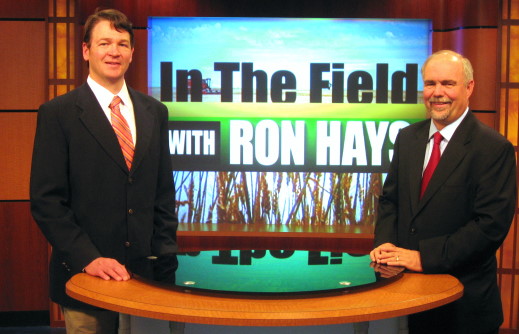
Agricultural News
Oklahoma Wheat Crop Better Than a Year Ago
Thu, 22 Jan 2015 17:55:17 CST

Mother Nature has the state's wheat crop off to a decent start. Oklahoma State University Extension Wheat Specialist Dr. Jeff Edwards said across most of the state the crop is sitting in good shape. Throughout the winter there has been adequate moisture, but the state remains short on sub-soil moisture.
"We certainly have the potential right now to produce a wheat crop that is well-above average," Edwards said. "If Mother Nature cooperates, I think we could come out well-above average and hopefully more than double what we produced last year, which isn't a just a tremendous number, but still I think we certainly have that potential."
Radio Oklahoma Network Farm Director Ron Hays interviewed Edwards about the state of the crop. Click or tap on the LISTENBAR below.
Many of the state's wheat farmers planted the crop early to allow it to be grazed by cattle. Edwards said that has an effect on the grain yield. OSU research has shown grazing lowers the crop's grain yield by 15 - 25 percent. He said half of that grain yield loss comes from planting the crop a month earlier than recommended to allow for grazing. The remaining yield loss is because of grazing, so Edwards recommends farmers focus on minimizing their yield losses.
"The way they are going to do that, is just make sure those cattle are off by first hollow stem and also try and monitor their stocking density," Edwards said.
OSU has found that if the wheat has around 60 percent ground cover when the cattle come off that yields can still be optimized within the dual purpose system. Edwards recommends farmers monitor the amount of green leaf area present. He said cattle may need to be removed earlier to allow the wheat crop more time to recover. Edwards said the crop is trying to rebuild leaf area in a short amount of time of about two to three week period versus in a grain-only system the crop has a two or three month period to regain that leaf area.
"If we can leave some extra green area out there, extra leaves out there, it really helps the crop in being able to recover from grazing," Edwards said.
Nutrients are also key to the crop's recovery process. With good yield potential, Edwards said farmers need to go ahead and top dress the crop with nitrogen. If farmers are using a nitrogen rich strip or sensor based method, he said there is no reason to delay application. If farmers are grazing the crop or using sensor-based applications, then it is alright to wait a little longer before applying. Once the cattle come wheat pasture, then it is good to apply nitrogen to replace some of the nutrients lost during grazing. Edwards said two pounds of Nitrogen makes a bushel of wheat, so applying $1 worth of nitrogen makes about $5 worth of wheat, making it a good investment. After last year's dismal wheat crop, Edwards understands farmers are being cautious in putting too much money into this crop. He thinks applying nitrogen is needed for the crop to capitalize its potential.
"I don't wind up in a situation where Mother Natures does cooperate, we are getting rainfall, but we don't have the fertility out there to fuel this crop throughout the spring and we miss out on a very good year, because we don't have the fertility out there to make the crop," Edwards said.
Edwards also encourages farmers to monitor for insects, disease and weeds. He said winter grain mites have been identified in fields around the state and those do a lot of damage to the crop. With warm temperatures for the next couple of weeks, he said that provides a good opportunity for applying herbicide before the crop begins growing this spring. Edwards does not anticipate farmers will have to apply a fungicide this year. He recommends farmers hold off applying a fungicide until the crop begins to head out.
In looking at wheat varieties, Edwards has been impressed how well OSU developed varieties are being adopted by farmers. OSU wheat varieties are on roughly 15 percent of the wheat acres in the Southern Great Plains and about 5.5 percent of the total wheat acreage in the US. Edwards new varieties like Gallagher, Iba and Ruby Lee are occupying a lot of those acres.
Edwards will be the featured guest on the In the Field TV segment that is seen Saturday mornings on KWTV, News9 at 6:40 AM.
WebReadyTM Powered by WireReady® NSI
Top Agricultural News
More Headlines...




















